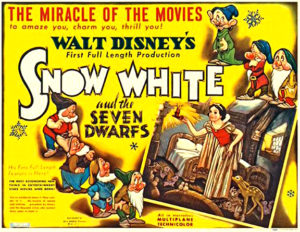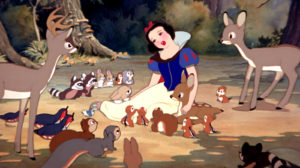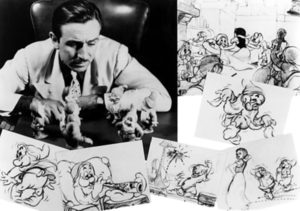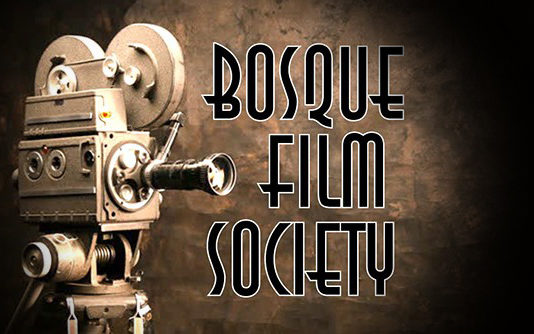Walt Disney’s first-full-length animated film “Snow White and the Seven Dwarfs” featured by Meridian Parks & Rec’s free Outdoor Movie Night at the John A. Lomax Amphitheater Sept. 19
by SIMONE WICHERS-VOSS
Bosque Film Society Board Member
MERIDIAN – “Lips red as the rose, hair black as ebony, skin white as snow, she is the fairest of them all,” the magic mirror says, sending Queen Grimhilde into a jealous rage, and making plans to kill an innocent young girl, her step-daughter Snow White. As the story unfolds, audiences are treated to a cornucopia of woods animals, funny scenes, exhilarating, exciting scenes and lots of memorable tunes.
Celebrating Walt Disney’s timeless, and much-loved first full-length animated movie, Meridian Parks and Recreation’s free monthly Outdoor Movie Night presents the cinematic classic Snow White and the Seven Dwarfs on Sunday evening, Sept. 19 at 7:30 p.m.
Because of busy schedules on Saturday evenings this fall, the free movie nights have been moved to Sunday evenings. Come and enjoy a free movie night at the John A. Lomax Amphitheater in Meridian Park and marvel at the incredible technical achievement from 85 years ago.

The movie poster for the movie’s December 1937 premier said “Three years in the making, an hour and a half in the showing and a lifetime of remembering. “
When the film premiered at the Carthay Circle theater audiences were amazed. With its engaging story – Snow White and the Seven Dwarfs was based on the 1812 German fairy Tale by the Brothers Grimm – distinct characters, vibrant art, and memorable songs, Snow White and the Seven Dwarfs set the animation standard for decades and generations to come.
America’s first animated feature was the biggest gamble of Disney’s career and its fortunes would either make or break the studio. While both his brother and business partner along with his wife Lillian attempted to talk him out of it, Disney employees worked countless hours of uncompensated overtime to see it through. Industry skeptics called it “Disney’s Folly” but instead it became one of the biggest box office hits before World War II.
The film was a critical and commercial success and, with international earnings of more than $8 million during its initial release – compared to its $1.5 million budget. As it turned out, Disney Studios in Burbank was built with the profits from the film. The popularity of the film led to its being re-released many times, until its home video release in the 1990s.
The movie was the start of the Disney’s fairy tale stereotypes coming to the big screen – the sweet, beautiful princess, the evil step mother and Prince Charming on his white horse to sweep the damsel in distress off to a Happily Ever After.

The classic was also the first animated movie produced in full color, and the first to be produced by Walt Disney Productions. And, it was the first Walt Disney Animation Studios film to use full opening credits.
The movie was also the first animated feature to be selected for the National Film Registry. In the first year of inductions in 1989, the movie was selected for being “culturally, historically, or aesthetically significant.” The American Film Institute ranked it among the 100 greatest American films, and also named the film “the greatest American animated film of all time.”
Snow White was nominated for Best Musical Score at the 1938 Academy Awards and it was the first film to ever have a soundtrack recording album released for it. Well-known songs from the film include “Heigh-Ho,” “Someday My Prince Will Come” and “Whistle While You Work.”
“Someday My Prince Will Come” has become a jazz classic that has been performed by numerous artists, including Buddy Rich, Lee Wiley and Oscar Peterson. It was also the title for albums by Miles Davis, Wynton Kelly and Alexis Cole.
In 1939, Disney was awarded an honorary Oscar for the film as producer, presented by Shirley Temple. It was one original-sized Oscar, with an additional seven small ones on a stepped base.
With each second of film taking 20-30 drawings by hand, an enormous group of people were at work putting together the scenes. Publicity material relates that production employed 32 animators, 102 assistants, 167 “in-betweeners,” 20 layout artists, 25 artists doing water color backgrounds, 65 effects animators, and 158 female inkers and painters. 2,000,000 illustrations were made using 1500 shades of paint.

Animator Shamus Culhane recalled drawing the Dwarfs’ march home in the “Heigh Ho” scene as one of the toughest assignments of his career. Although six of the Dwarfs were marching at the same tempo, he had to give each his own body language suited to the character; and he had to map each individual walk with a blue pencil and ruler because of the unusual angles and perspectives used in the sequence. Then there was Dopey, bringing up the rear, hopping out of step with the others but who still had to be smoothly integrated into the action.
Describing the sheer amount of painstaking hand-drawn labor this involved, Culhane said, “I worked six months on that goddamned thing, and it doesn’t last a minute onscreen.”
The original names of the Dwarfs were Snick, Glick, Blick, Flick, Plick, Whick and Quee before Disney renamed them Bashful, Sleepy, Happy, Grumpy, Sneezy, Doc, and the most popular dwarf of all, Dopey.
Peanuts creator Charles M. Schulz once wrote that he had heard that another name considered for a dwarf was “Snoopy.” If it had been chosen Schulz would have had to find an alternative name for his famous cartoon beagle.

Fun things to watch for while viewing the film are:
- In the dwarves’ home, almost every wooden surface has an animal carved into it. Even the edge of each stair-step is the face of an owl. Only the door to the bedroom looks to have smiling human-shaped creatures on it.
- Happy is the only one of the seven dwarfs who has white eyebrows. All the rest have black eyebrows.
- Dopey is the only one of the seven dwarfs who does not have a beard.
- Despite his name, Sneezy only sneezes four times throughout the movie – not counting the two that are stifled.
- All of the dwarfs have dark eye color except for Dopey; his are light blue.
- The Queen is supposed to be Germanic in origin, but the book of spells she is reading is written in the Italian language.
- There is a hidden Mickey formed by three stones on the wall behind the Queen as she strides down to the basement to perform her spell.
- Snow White not once interacts with the Prince. This makes her the only Disney Princess who does not talk to her love interest.
This vibrant, fun, fantasy for all ages remains an exceptional achievement in animation history and very worthwhile seeing. It’s an important work of art that should continue to be celebrated and the songs to be sung. So bring your lawn chair, your blanket, partake of the free popcorn, other snacks and water Sept. 19 and enjoy this cinematic classic.
Photos by WALT DISNEY PICTURES & SWANK MOTION PICTURES, INC.
©2021 Southern Cross Creative, LLP. All rights reserved. This material may not be published, broadcast, rewritten, or redistributed.
